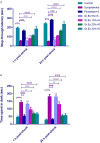Grewia asiatica Berry Juice Diminishes Anxiety, Depression, and Scopolamine-Induced Learning and Memory Impairment in Behavioral Experimental Animal Models
- PMID: 33521033
- PMCID: PMC7844311
- DOI: 10.3389/fnut.2020.587367
Grewia asiatica Berry Juice Diminishes Anxiety, Depression, and Scopolamine-Induced Learning and Memory Impairment in Behavioral Experimental Animal Models
Abstract
Grewia asiatica L. fruit natively called phalsa is a popular berry of Pakistan and widely consumed in the form of fresh juices and carbonated drinks in the summer season. The berry is enriched with antioxidants such as phenols, flavonoids, anthocyanins, and vitamin C. Scientifically, it is the least explored berry in terms of neuromodulatory activities, and therefore, in the designed study, chronically fed rats with the different dilutions (5%-30%) of fruit juice were subjected to behavioral assessment for anxiety, depression, and cognition (spatial memory) followed by biochemical analysis of isolated brains. Results revealed a prominent impact of 20 and 30% dilutions of fruit exudate as treated animals showed anxiolytic behavior to central zone (P < 0.05) of open field test (OFT) and open arms of elevated plus maze (EPM) (P < 0.05) in anxiety models. Overall, immobility of rats treated with a higher concentration of exudate in forced swim test (FST) was reduced (P < 0.05) presenting antidepressant-like activity. Moreover, in learning and memory experimental models, the treated animals reversed scopolamine-induced amnesic effects as evident from improved step-through latencies (P < 0.05 vs. scopolamine; passive avoidance test), spontaneous alternation behavior (P < 0.05 vs. scopolamine; Y-maze test), discrimination index (P < 0.05 vs. scopolamine; novel object recognition test), and escape latencies (P < 0.05 vs. scopolamine; Morris water maze). Biochemical studies of isolated brains from treated rats demonstrated significantly elevated levels of superoxide dismutase and glutathione peroxidase (P < 0.05), whereas levels of acetylcholinesterase and malondialdehyde level (P < 0.05) were reduced, indicating its potential to reduce oxidative damage in the brain and modulation with the cholinergic system. The outcomes of studies support the benefits of phytoconstituents possessed by G. asiatica fruit in the amelioration of neurological disorders that could be due to their antioxidative capacity or due to interaction with GABAergic, serotonergic, and cholinergic systems in the brain.
Keywords: Grewia asiatica; Morris water maze; amnesia; anxiety; depression; escape latency.
Copyright © 2021 Imran, Javaid, Waheed, Rasool, Majeed, Samad, Saeed, Alqahtani, Ahmed and Alaqil.
Conflict of interest statement
The authors declare that the research was conducted in the absence of any commercial or financial relationships that could be construed as a potential conflict of interest.
Figures











References
-
- Smith R. Let food be thy medicine. BMJ. (2004) 328.
LinkOut - more resources
Full Text Sources
Other Literature Sources
Miscellaneous

